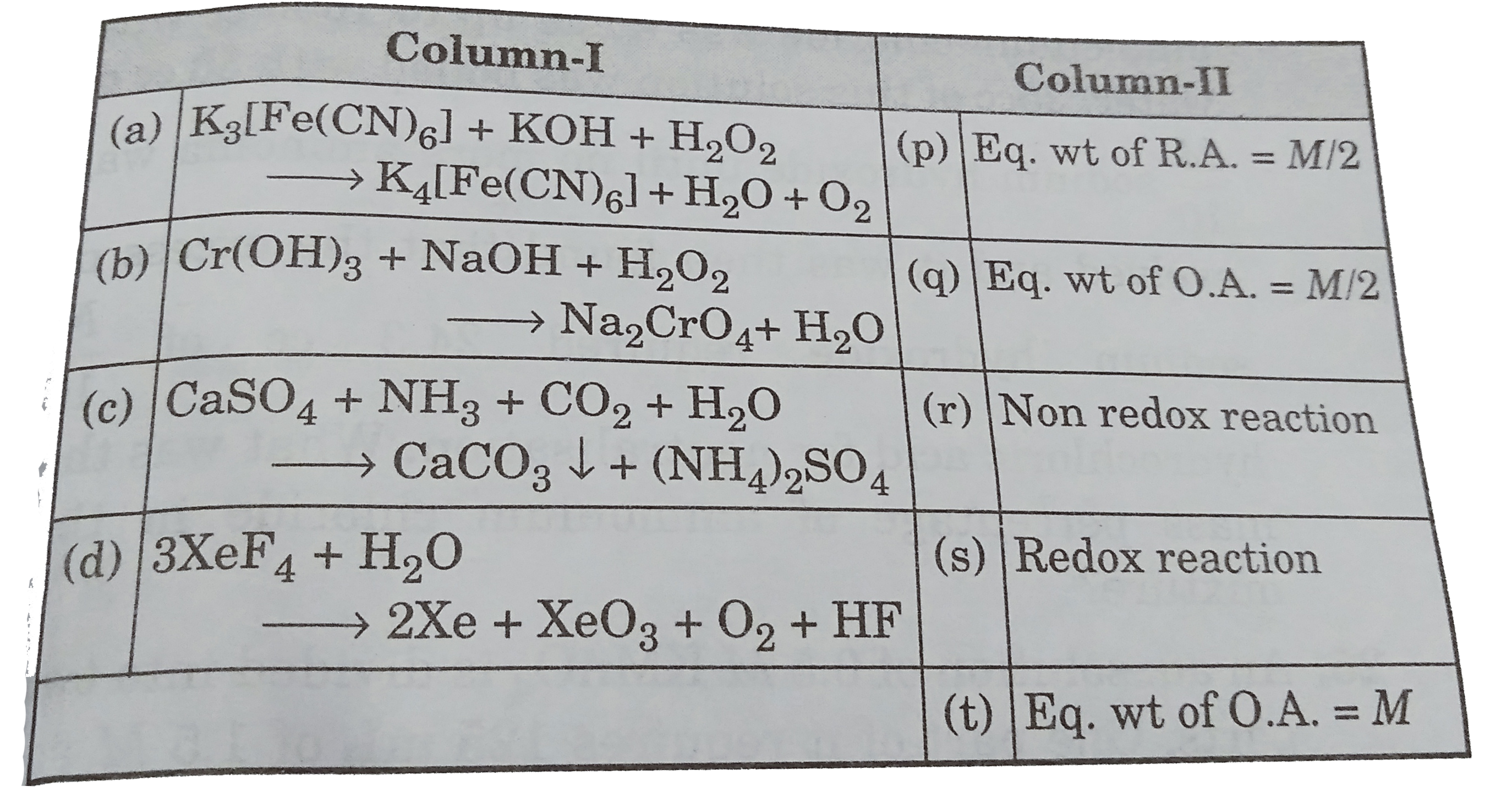The equivalent weights of oxidising and reducing agents can be calculated by the number of electrons gained or lost. The equivalent weight of an oxidising agent is the number of parts by weight of the substance which gains one electron. Thus, it is equal to the molecular weight of the substance divided by the number of electrons gained in the balanced chemical equation. Similarly, equivalent weight of a reducing agent is equal to the molecular weight divided by the number of electrons lost as represented in the balanced chemical equation
The equivalent weight of barium in BaCrO4 used as an oxidising agent in acidic medium is (At, wt, of Ba - 137.34)Solution in Telugu
137.34
45.78
114.45
68.67
The correct Answer is:B
In acidic medium BaCrO4 is converted into
BaCr2O72CrO2−4+2H+→Cr2O2−7+H2O
CrO2−7+14H++6e−→2Cr3++7H2O
2CrO2−4+16H++6e−→2Cr3++8H2O
Thus 2BaCrO4≡6e− or BaCrO4≡3e−
∴ Eq. wt of Ba2+=13×At . wt
=13×137.34=45.78
Topper's Solved these Questions
- REDOX REACTIONSBOOK - AAKASH SERIESCHAPTER - REDOX REACTIONSEXERCISE - LECTURE SHEET (EXERCISE - II) (LEVEL - II (ADVANCED)) (Matrix Matching Type Questions)
2 Videos
- REDOX REACTIONSBOOK - AAKASH SERIESCHAPTER - REDOX REACTIONSEXERCISE - LECTURE SHEET (EXERCISE - II) (LEVEL - II (ADVANCED)) (Integer Type Questions)
8 Videos
- REDOX REACTIONSBOOK - AAKASH SERIESCHAPTER - REDOX REACTIONSEXERCISE - LECTURE SHEET (EXERCISE - II) (LEVEL - II (ADVANCED)) (More than One correct answer Type Questions)
7 Videos
- PURIFICATION OF ORGANIC COMPOUNDS AND IUPAC NOMENCLATUREBOOK - AAKASH SERIESCHAPTER - PURIFICATION OF ORGANIC COMPOUNDS AND IUPAC NOMENCLATUREEXERCISE - ADDITIONAL PRCATICE EXERCISE (LEVEL - II (LECTURE SHEET (ADVANCED) INTEGER TYPE QUESTIONS)
2 Videos
- REVISION EXERCISE BOOK - AAKASH SERIESCHAPTER - REVISION EXERCISE EXERCISE - CHEMICAL EQUILIBRIUM
107 Videos
Similar Questions
Match the redox process in Column - I with n - factor for underlined species in Column - II

View SolutionIn the reaction SnO2+nC→Sn+nCO then the value of n is _____
View SolutionThe equation for a reaction is shown below: 2MnO−4+5H2O2+6H+→2Mn2++8H2O+5O2
Which of the following statements about this reaction are correct ?
View Solution
How many types of functional groups are present in given compound
View Solution50 g CaCO3 is allowed to dissociated in 22.4 lit vessel at 819∘C . If 50% of CaCO3 is left at equilibrium , active masses of CaCO3 , CaO and CO2 respectively are
View SolutionEquivalent Weight Of Substances That Act As Both Oxidising And Reducing Agents
View SolutionEquivalent Weight Of Substances In Which Both Cations And Anions Are Oxidised
View SolutionAtomic weight of barium is 137.34 The equivalent weight of barium is BaCrO_(4) used an an oxidising agent in acid medium is
View Solution
(O.A=Oxidising agent, R.A= Reducing agent, M= Molecular weight)
View SolutionEquivalent weight of oxidizing or reducing agent is
View SolutionAssertion :- Equivalent weight of NH3 in the reaction N2→NH3 is 17/3 while that of N2 is 28/6.
Reason :- Equivalent weight=Molecular weightnumber of e− lost or gained/mole
View SolutionThe equivalent weights of KMnO4 as an oxidising agent in acidic and neutral media will be respectively (M = molecular weight of KMnO4 )
View SolutionEquivalent weight of the oxidising agent in the unbalanced reaction :- MnO_(4)^(-)+Fe^(+2) to Mn^(+2)+Fe^(+3) is:- (M=molecular weight)
View SolutionKMnO4 acts as an oxidising agent in the presence of dil H2SO4. Its equivalent weight is (M is molecular weight)
View SolutionThe equivalent weights of oxidising and reducing agents can be calculated by the number of electrons gained or lost. The equivalent weight of an oxidising agent is the number of parts by weight of the substance which gains one electron. Thus, it is equal to the molecular weight of the substance divided by the number of electrons gained in the balanced chemical equation. Similarly, equivalent weight of a reducing agent is equal to the molecular weight divided by the number of electrons lost as represented in the balanced chemical equation Equivalent weight of MnO_(4)^(-) in acidic, basic and neutral media are in the ratio of
View Solution
